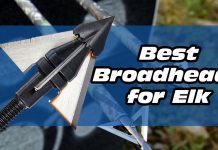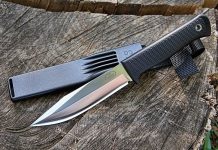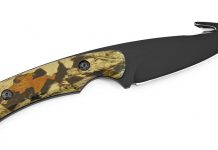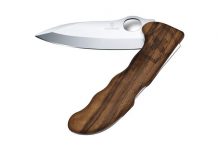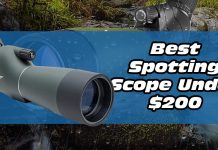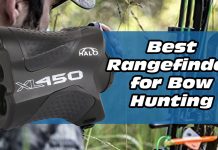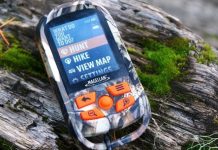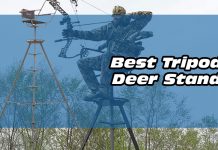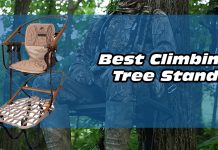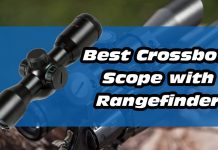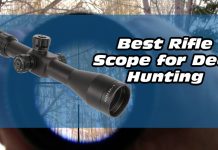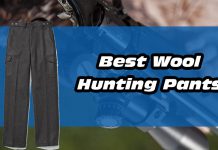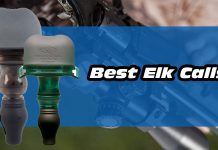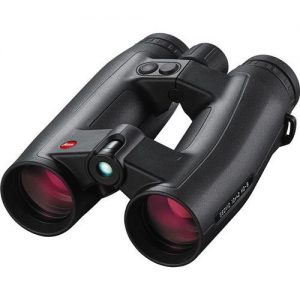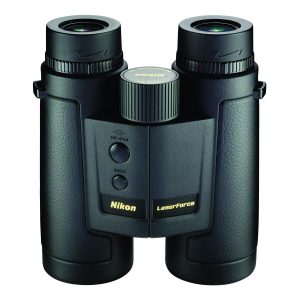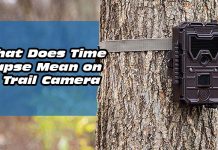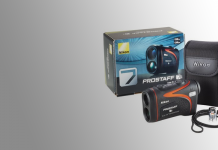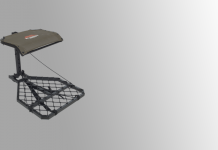Best Rangefinder Binoculars – Top Laser Range Finding Binocular Set Review 2020
When you’re hunting, you need the greatest accessories and tools. How do you make sure you have the best? When it comes to the optics, old technologies were never quite up to par. Rangefinder binoculars have currently been perfected to bring you the best optics as you hunt, with a combination of laser rangefinder technology, and the glassing from binoculars. As you hunt, you’ll have the greatest optics in the field.
Rangefinders are an essential aspect for any hunter or sporter, as it’s a device that helps you accurately measure the distance that’s between your target, and you. Binoculars are also important, as they’re used to observe and take in details of objects that are too far away to make out clearly with the blind eye. When these two essential hunting devices are combined to give you a binocular that also shows you distance, this is a rangefinder binocular. Rangefinder binoculars come in handy, because they have many features and are easy to use, which lends to enhancing your hunting performance.
These binoculars have become very popular among hunters, whether they take their binoculars into the woods, or onto the shooting range. Some people even say that rangefinder binoculars may completely replace traditional, plain binoculars as essential hunting equipment. In this article, you’ll be introduced to this type of equipment, can browse the top products, and find out which features you should look for in a rangefinder binocular.
The Best Rangefinder Binoculars
| ① MLeica Geovid 10x42- TOP PICK |  |
| ② Nikon LaserForce 10x42 |  |
| ③ Vortex Fury HD 10x42 |  |
| ④ Steiner Nighthunter 8x30 LRF |  |
| ⑤ Swarovski El Range 10x42 w/Field Pro |  |
| ⑥ Swarovski El Range 10x42 w/Field Pro |  |
How do Rangefinder Binoculars Work?
At its basic, a rangefinder binocular shows you the distance between your target and yourself, while simultaneously allowing you to view your target closely and get details you can’t with the naked eye. A device that combined a binocular’s display with the function of measurement that’s typically shown by a rangefinder came into being because of the US military. The military needed this type of tool to collect data for their missions, but also needed to maintain a safe distance from their targets. Soon rangefinder binoculars became commercially available, and many hunters have incorporated it into their arsenal.
Binocular rangefinders operate using the principle of shooting lasers on targets, then using this to calculate distance. However, it doesn’t stop there. Due to expanding technology, rangefinders have vastly improved, especially when it comes to accuracy. The most up to date rangefinders will include many features that make the range measuring of targets more easy and efficient. With the combination of binocular technology, you’ll have an easier time hunting than ever before.
The Best Rangefinder Binoculars
If you’d like to have all the benefits of rangefinders with the close-up view of binoculars, the combination will bring you many advantages and may improve your hunt. Advanced technology, great glass, and good distance reach allow you to apply optics to a productive hunt. Here are the best six rangefinder binoculars that are currently available.
1)Leica Geovid 10×42
Leica often holds top rankings in many lists and lineups when it comes to rangefinder binoculars. Leica is a reputable manufacturer, and its rangefinder binocular isn’t too expensive yet offers many impressive features, such as Advanced Ballistic Compensation (ABC) technology. This technology allows you to utilize calculations that you specify and pre-load yourself, in order to adjust the scope of your rifle and compensate for holdovers and angles. Leica also provides 2,000 yards of ranging that’s completely accurate, as well as LED in-view display, weatherproof features, and submersible durability. Lecia truly has everything, and is very popular among hunters.
2)Nikon LaserForce 10×42
Nikon is making its own stand in the market of rangefinder binoculars. In fact, Nikon is making an impression and doing well with its LaserForce binoculars. This rangefinder binocular’s features are well known to be tight and clean, and you’ll get exactly what the advertisements promise. There’s distance measurement of 1,900 yards, and although this doesn’t extend to deer and other such soft targets, you’ll still be able to get positive target acquisition for more than 600 yards. Many hunters believe for its price, that the LaserForce is definitely worth it.
Features include ID (Incline/Decline) Technology that’s built in to give you angled compensated distances, so you can make adjustments to your riflescope efficiently and accurately. There’s also an LED display that allows you to see all your readings clearly no matter what time of the day, with a brightness intensity that has four settings. With the LaserForce, Nikon definitely doesn’t disappoint, and it’s definitely making its presence felt in the rangefinder binoculars market.
3) Vortex Fury HD 10×42
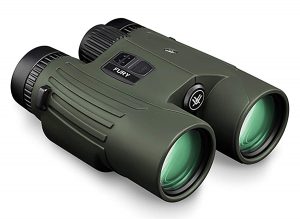
Many hunters are loyal to the Vortex brand, and when it released its Fury HD rangefinder binoculars, it caused a lot of excitement. This binocular is a class act optic device with a maximum ranging distance of 1,600 yards, and 1,000 yards for deer. A display that’s softly illuminated is easy to see and read, even in conditions where there isn’t must light, and you can adjust the brightness and resolution as darkness falls during your hunt.
Special features include phase-correction coatings that are dielectric, and the ability to get extreme long shots and angle compensated distances. The glass is also High-Density ED. And the delivery of all features is easy to use and intuitive, making the Fury HD Vortex’s best binoculars yet.
4)Steiner Nighthunter 8×30 LRF

Steiner is a very prestigious brand that sports a high price tag within optics brands, however, it’s similar to Zeiss sales and is a little less than Leica. With the Nighthunters, Steiner really holds its own against many other brands in the rangefinder binocular space. However, the Nighthunter has a Porro prism design that many hunters dislike, and it definitely isn’t for everyone as it’s a little difficult to look at. For some, they may find the design is preferable over traditional roof prism designs, as the Nighthunter does offer a richer and deeper field of view. It also contains Sports-Auto Focus Technology, and has individual eyepieces. The binocular also ranges to 1,860 yards, which is impressive.
5)Swarovski El Range 10×42 w/Field Pro
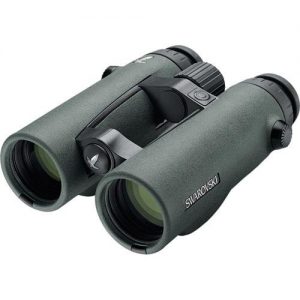
This binocular is the most expensive in the list, and it is definitely a sight to see. However, Swarovski delivers high quality for its high price. The brand has established itself as an authority in the market of hunting optics, and the El Range holds to the standard. It doesn’t have ballistic data, but it does feature SwaroAim, which helps you compensate angles and distances so you can make adjustments to your rifle scope. As you may expect, the optics are excellent as well, with SwaroBright, which is an integrated diopter, and there’s also a center focus that locks. Even external features are great, as Swarovski prides on meticulous detail.
6)Bushnell Fusion 1 Mile ARC
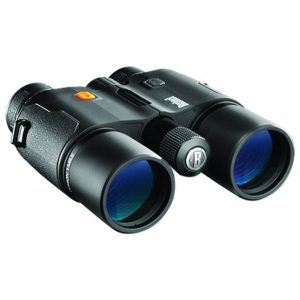
This rangefinder binocular is a great buy for the combination of its excellent price and excellent features. The American brand does well with the Fusion, which ranges out at 1,760 yards. Bushnell is also an honest brand, as it fully discloses that the soft target ranging of these binoculars is just 500 yards, which is still impressive depending on your intentions for hunting. The Fusion also still offers many excellent features, as it comes in both Rifle and Bow modes, has Angle Range Compensation (ARC), Various Sight-In (VSI) zeroes, and Matrix Display Technology, all close at hand and simple and easy to use. Its optics also contain additional technologies that are patented by Bushnell, so your image quality is always the greatest it can be.
Features to Look For As You Purchase Rangefinder Binoculars
As you try to find the best rangefinder binoculars for yourself, you may run into some difficulty, even if you have a basic idea of what they are and a budget in mind. You don’t want to end up putting off your purchase, be unsure about what you’re getting, or get a product that you don’t have complete faith in. If you find rangefinder binoculars that have the following features, they’ll be great for you, and you won’t have to worry too much.
- Price. Arguably the most important feature to hunting equipment is whether or not it fits within your budget. Before you even research rangefinder binoculars, you should have a set price in mind, and be realistic about what you can spend. This will help narrow down your search, and you don’t want to either spend too little on a low-quality product, or spend more than you’re able to afford. Ideally, your purchase won’t be a burden on you. Once you’ve picked a range or a specific price, you can disregard rangefinder binoculars that cost either too little or too much. From there, you can conduct research and figure out the best ones.
- Your intentions and expectations. Another important factor is to take into consideration exactly what you’d like to get out of your rangefinder binocular. Disregard what other people are telling you, and take the time to figure out what’s important for yourself and what you need from it. Write down some reasons you’d like to buy a rangefinder binocular, or feel you need one for hunting, in the first place. Then try to find a binocular–within your budget–that matches most, if not all, of those reasons. It all depends on requirement, perspective, occasion, and comfort. This’ll also help to narrow down your search.
- Objective and magnification. The objective and magnification belonging to a binocular are typically complimentary. The two aspects will also play a hand in the exact range of a rangefinder binocular. If you see binoculars classified by a group of numbers, like 10×42 or 7×20, what this indicates is the magnification and diameter of the objective lens. A 7×20 binocular means that the magnification is seven times, and the diameter of the objective lens is twenty. If you’re getting rangefinder binoculars for the purpose of sports, a seven magnification is perfectly fine. If you’re a hunter, however, a great option is ten times the magnification.
- Something you should be aware of though is that with each magnification increase, your field of view will reduce. For example, the field of view of a rangefinder binocular that has seven times magnification is actually larger, than that of a binocular that has ten times magnification.
- Also, the larger the numbers, the heavier the binocular will be, meaning that you’ll have difficulty holding it up for long periods of time as you hunt. If you’d like lighter equipment, stick to the smaller numbers, or you may need a tripod stand.
-
- Depending on the binocular rangefinder you purchase, there might be a feature that changes the magnification. In this case, you’ll be able to alter the magnification according to the range. For example, if the binocular says it’s 7-15×40, you’ll be able to adjust the magnification manually to any number between seven and fifteen. Usually, there’s a wheel or lever you can turn on the binocular in order to do this. While this provides great versatility, it may negatively impact the image’s quality.
-
- Prism and glass. The quality of the prism, or glass, that is located within the rangefinder binocular can have a large impact in measurement of the range. A generic, cheap glass can negatively impact the image’s quality that the binocular provides by creating a dent. Any bend in the glass, slight or not, can put the colors off, and project the target oddly. If you’d like a quality image that isn’t distorted, glasses that are low or extra low dispersed are most ideal. These are known as specialized glasses, and they won’t bend light as they transmit it, which gives you clear, great images without off colors or projections. As you browse binoculars, become familiar with the type of prism or glass that the manufacture used within it.
- Another aspect you should be aware of is the coating of the lens. Lens coating is a thin film that is applied directly to the lens, and it helps reduce glares and reflections, both of which could affect the way you see your target. The lens also enhances the transmission of light, and makes colors more vibrant. You should know that the coating benefits the binoculars overall; it isn’t just to help with the aesthetic look of the device.
- Field of view versus angle of view. These two features are essentially exactly alike. They’re both a measurement of scenery, which you calculate as you look into your rangefinder binocular. The angle of view is measured in degrees, however, it’s also expressed as Apparent Angle of View (AAOV). It’s calculated by multiplying the angle of view with the magnification of the binoculars themselves. The AAOV is the magnified field you’ll see as you look into a binocular. If the AAOV increases, the field of view becomes wider. If the angle is 65 degrees or above, the AAOV is considered wide.
- Minimum and maximum focus distance. The entire idea behind rangefinder binoculars is that you’re able to observe things that are far away. Ideally, you’d like the maximum rage possible for the binocular you end up buying. As the magnification number increases, the range will increase. You should pick magnification that is best suited to your own personal skills and needs. For example, bird watchers only need binoculars that have minimum, yet great, range, as they’ll be looking at tree branches that are nearby. In this instance, the minimum focus distance needs to be less than the distance between the tree, and the person. This is a good aspect to keep in mind.
- Housing and design. The design of your rangefinder binoculars may make a big impact. They should be lightweight and compact, so you can pack them and handle them very easily. What will define efficiency is the weight, as you need to consider whether you’re interested in purchasing a tripod in order to hold a heavier binocular, or if you’re fine with something smaller. On the other hand, if the device is too small and compact, it could fall from your hands or your pack and either break or get lost. You should strike a balance, between compactness and efficiency, for your great rangefinder binocular.
- When it comes to the housing, your rangefinder binoculars should be very comfortable and sturdy. They should be able to withstand some wear and tear, and if they’re waterproof, that’s a great plus. If it has features such as fog resistance, that’s even better.
The Best Rangefinder Binoculars
| ① MLeica Geovid 10x42- TOP PICK |  |
| ② Nikon LaserForce 10x42 |  |
| ③ Vortex Fury HD 10x42 |  |
| ④ Steiner Nighthunter 8x30 LRF |  |
| ⑤ Swarovski El Range 10x42 w/Field Pro |  |
| ⑥ Swarovski El Range 10x42 w/Field Pro |  |
How to Find A Quality Rangefinder Binocular
Now that you understand which features to look for, how do you know, bottom line, that the device you’re purchasing is the quality you’d like it to be? Whether you’re going all in or you want something small for birdwatching, there are aspects you can pay attention to in order to determine the quality of the binocular. This’ll help you get past the marketing and fancy words, and use fundamental components to take a look at the actual construction of the device to determine how well-built it is.
- Cost: quality typically goes hand-in-hand with a brand, but you will be able to find great binoculars that you won’t have to pay a small fortune for even if it’s from an unfamiliar brand, and vice versa, sometimes you pay more for the name than the device itself. The ability to match features and quality against price is key to landing the best rangefinder binoculars for your intents and purposes. If you go for a cheap device, the glass quality may not be great. To determine a good price for the best value, take a look at the glass and other features.
- Quality glass and coating: Look for glass elements such as ED and HD that are of premium quality. There may also be coatings such as phase correction, mirror, and layered coatings, as well as scratch, weather, and debris resistance. Quality binoculars will protect the glass from the elements.
- High-end focus system: This system will include IF, dual focus, and fast focus systems.
- Distance: Rangefinder binoculars are known for their excellent distance reach. However, you’ll need to make sure that the quality of the glass is able to withstand the distance reach the binoculars claim to have; that distance is worthless if the glass isn’t of good quality.
- Eye relief: If your binoculars don’t have decent eye relief, it may be useless to glass with. Your eye relief should be 15-20mm.
- Durability: Often, a rangefinder binocular that is resistant to rain isn’t enough. If you’re invested in durability, you should also look for submersible optics.
- Adaptable for tripods: If your rangefinder binocular costs on the high side, chances are it’s bigger, which means that it’s also heavier. It’ll be tough for you to hold the binocular for long periods of time, so you’ll need a tripod to mount it, and if it’s not tripod adaptable, it may be worthless. With tripods, you’ll get images that are stable and distance readings that are accurate.
- Warranties: Quality warranties bring you assurance that you’re fully covered, and are worth it.
Matching value with quality may be tiring, but it’s an essential aspect to the buying process, and you can achieve it successfully if you know the worth of certain components and features. Remember to keep your specific activities in mind as well, as this’ll keep you realistic about your purchase.
Conclusion on the Best Rangefinder Binoculars
Whether you’re a casual hunter, just birdwatching, or need better optics to improve your game as you hunt deer, rangefinder binoculars are a must-have for every hunter. They bring you the best of both worlds: with rangefinder technology, you’ll be able to measure the distance between you and your target, and with the binoculars, you can see your target up close and be able to take in more details than you would with just the naked eye. As you look for your rangefinder binoculars, make sure you keep certain aspects in mind, such as your budget, your optical needs and intentions for the device, and quality of features. With all this information, check out the products on the list, and see if any of them are a great fit for you. No matter what, you will find the best rangefinder binoculars for yourself.


